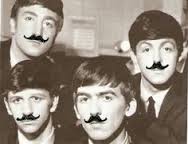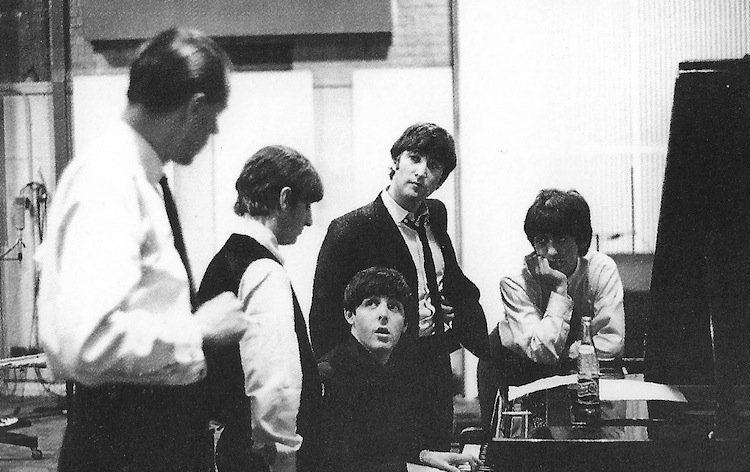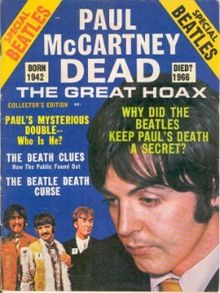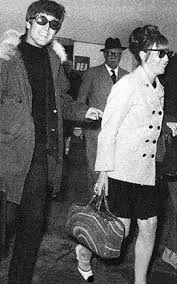Moustaches were catching like the flu- not only do the Fab Four grow them, Beatles assistants Mal Evans and Neil Aspinall grow 'em to.

Moustaches were catching like the flu- not only do the Fab Four grow them, Beatles assistants Mal Evans and Neil Aspinall grow 'em to.

The Beatles each doing their own thing today.
Nothing notable happened on this day 50 years ago.
One week after beginning his road trip across France, Paul McCartney had a rendezvous with The Beatles' roadie Mal Evans in Bordeaux.
Prior to meeting Evans, McCartney spent the night in a Bordeaux club. Wearing the moustache and glasses disguise he had prepared to allow him to travel incognito, the club staff wouldn't let him in.
I looked like old jerko. 'No, no, monsieur, non' - you schmuck, we can't let you in! So I thought, Sod this, I might as well go back to the hotel and come as him! So I came back as a normal Beatle, and was welcomed in with open arms. I thought, Well, it doesn't matter if I've blown my cover because I'm going to meet Mal anyway, I don't have to keep the disguise any longer. Actually, by the time of the club I'd sort of had enough of it. Which was good. It was kind of therapeutic but I'd had enough. It was nice because I remembered what it was like to not be famous and it wasn't necessarily any better than being famous.It made me remember why we all wanted to get famous; to get that thing. Of course, those of us in the Beatles have often thought that, because we wished for this great fame, and then it comes true but it brings with it all these great business pressures or the problems of fame, the problems of money, et cetera. And I just had to check whether I wanted to go back, and I ended up thinking, No, all in all, I'm quite happy with this lot. McCartney met Evans at the Saint-Eloi catholic church, on Rue Saint-James in Bordeaux.
We met up, exactly as planned, under the church clock. He was there. I figured I'd had enough of my own company by then. I had enjoyed it, it had been a nice thing. Then we drove down into Spain but we got to Madrid and we didn't know anyone; the only way would have been to go to a club and start making contacts. So we thought, This is not going to be any fun, and rang the office in London, and booked ourselves a safari trip.
The pair drove from Bordeaux to Spain, making films on their journey. They had hoped to meet John Lennon in Almería, but filming for How I Won The War had ended and he had returned to England.
Instead they decided on a safari holiday and flew to Kenya. McCartney arranged to meet his girlfriend Jane Asher there, and in Seville had someone drive his Aston Martin DB5 back to London.
McCartney and Evans flew from Seville to Madrid, and from there to Nairobi. They had a 10-hour stopover in Rome, during which they did some sightseeing.
Upon their arrival in Kenya they toured Ambosali Park, overlooked by Mount Kilimanjaro, and stayed at the Treetop Hotel, the royal family's Kenyan base. The holiday came to a close on 19 November, when McCartney, Asher and Evans flew from Nairobi back to London.
Room 65, EMI Studios, Abbey Road
Engineer: Peter Bown
This was the last of four mixing sessions to prepare stereo versions of Beatles songs ahead of the UK compilation album A Collection Of Beatles Oldies on December 9, 1966.
Once again George Martin was not present, so the session was led by balance engineer Peter Bown. The first song worked on was "This Boy", which was the result of a misunderstanding. During a telephone call from EMI's headquarters at London's Manchester Square, Bad Boy was mistakenly called This Boy.
This led to stereo mixes being made from takes 15 and 17, which were edited together towards the end of the session. They were unnecessary, however, and the stereo mix of Bad Boy from May 10, 1965 was used for the album.
Day Tripper was the second song to receive a stereo mix. This replaced an earlier one made on October 26, 1965 for The Beatles' US and Australian record labels.
The third and final song was "We Can Work It Out". A previous stereo mix had been created on November 10, 1965, but was crapped on August 9, 1966.

The 'Paul Is Dead' myth began in 1969, and alleged that Paul McCartney. The Beatles are said to have covered up the death, despite inserting a series of clues into their songs and artwork. The story goes that at 5am on Wednesday - 9 November 1966, McCartney stormed out of a session for the Sgt. Pepper's Lonely Hearts Club Band album, got in to his Austin Healey car, and subsequently crashed and died.
Somewhat improbably, McCartney was said to have been replaced by a lookalike, called variously William Shears Campbell or William Sheppard. William Campbell allegedly became Billy Shears on Sgt Pepper, while William Sheppard was supposedly the inspiration behind "The Continuing Story of Bungalow Bill" (actually an American named Richard Cooke III).
In fact, the crash never happened. Between 6 and 19 November 1966, McCartney and his girlfriend Jane Asher were on holiday, travelling through France and Kenya.
However, a couple of relevant incidents did take place. On December 26, 1965 McCartney crashed his moped, resulting in a chipped tooth and a scar on his top lip, which he hid by growing a moustache.
Additionally, on 7 January 1967 McCartney's Mini Cooper was involved in an accident on the M1 motorway outside London, as a result of which it was written off. However, the car was being driven by a Moroccan student named Mohammed Hadjij, and McCartney was not present.
Hadjij was an assistant to London art gallery owner Robert Fraser. The pair turned up at McCartney's house on the evening of 7 January, and were later joined by Mick Jagger, Keith Richards, Brian Jones and antiques dealer Christopher Gibbs.
The party decided to head to Jagger's home in Hertfordshire, before moving on to Redlands, Richards' Sussex mansion (and scene of his later drugs bust). McCartney travelled with Jagger in the latter's Mini Cooper, while Hadjij drove in McCartney's Mini.
The two cars became separated during the journey. Hadjij crashed McCartney's Mini and was hospitalised with injuries. The heavily customised car was highly recognisable, so rumours began circulating that McCartney had been killed in the incident.
The following month a paragraph appeared in the February 1967 edition of the Beatles Book Monthly magazine, headed "FALSE RUMOUR":
Stories about the Beatles are always flying around Fleet Street. The 7th January was very icy, with dangerous conditions on the M1 motorway, linking London with the Midlands, and towards the end of the day, a rumour swept London that Paul McCartney had been killed in a car crash on the M1. But, of course, there was absolutely no truth in it at all, as the Beatles' Press Officer found out when he telephoned Paul's St John's Wood home and was answered by Paul himself who had been at home all day with his black Mini Cooper safely locked up in the garage.
Although the magazine downplayed the incident, and claimed the car was in McCartney's possession.
Belief that Paul McCartney may have died in the mid 1960s began in 1969. The first known print reference was in an article written by Tim Harper which appeared in the 17 September edition of the Times-Delphic, the newspaper of the Drake University in Des Moines, Iowa.
Harper later claimed that he wasn't the original source for any of the claims in his articles. He said he was writing for entertainment purposes only, and said he got the information from a fellow student, Dartanyan Brown. Mr Brown is said to have got the story from a musician who had heard it on the Californian west coast, and that he also read the story in an underground newspaper.
The rumours gained momentum on 12 October 1969, after an on-air phone call to radio presenter Russ Gibb, a DJ on WKNR-FM in Michigan. The caller, identified only as 'Tom', claimed that McCartney was dead, and instructed Gibb to play Revolution 9 backwards, where the repeated "number nine" phrase was heard as "turn me on, dead man".
Listening to the show was Fred LaBour, an arts reviewer for student newspaper The Michigan Daily. LaBour used clues from Gibb's programme along with others he had invented himself - including the name of William Campbell, the alleged replacement for McCartney.
The Michigan Daily published it on 14 October, under the title McCartney Dead; New Evidence Brought To Light. Although clearly intended as a joke, it had an impact far wider than the writer and his editor expected.
Shortly afterwards, Russ Gibb co-produced a one-hour special called The Beatle Plot, giving the rumour greater prominence; by then it was well on its way to become a national, then international, talking point, inspiring fans to pore over their albums for further clues.
A British version of the rumour is believed to have existed prior to the American one, with fewer details. The sources are unknown, but the notion of McCartney dying in a road accident appears to have originated there.
Although The Beatles and their press office at Apple were initially bewildered and somewhat annoyed by the story's refusal to die away, there is evidence that the group members themselves found it amusing.
In an edition of Life magazine dated 7 November 1969, McCartney reassured fans that "Rumours of my death have been greatly exaggerated," paraphrasing Mark Twain. "However," he continued, "if I was dead, I'm sure I'd be the last to know."
The magazine's cover featured Paul and Linda with their children, in a picture taken on their Scottish farm. The cover featured the words "The case of the 'missing' Beatle - Paul is still with us". Shortly after the issue went on sale the rumours started to decline.
In his revealing Rolling Stone interview in 1970, John Lennon was asked about the death story. He responded in a typically forthright fashion:
Lennon referred to the myth in 1971's How Do You Sleep?, his vitriolic attack on McCartney from the Imagine album. The song contains the lines: "Those freaks was right when they said you was dead, the one mistake you made was in your head".
McCartney parodied the rumours with the title and cover or his 1993 album Paul Is Live. The artwork was based on the Abbey Road cover photograph; instead of the 28IF number plate, a car shows 51 IS instead. To reinforce the cycle of life, he is pictured being dragged across the famous zebra crossing by one of the offspring of his sheepdog Martha.

Room 53, EMI Studios, Abbey Road
Engineer: Geoff Emerick
George Martin was not present for this third stereo mixing session for the UK compilation A Collection Of Beatles Oldies compilation, which was released on December 9, 1966, so balance engineer Geoff Emerick oversaw the work.

On the day before her exhibition Unfinished Paintings And Objects was to open, Japanese artist Yoko Ono was introduced to John Lennon for the first time.
John Lennon - That old gang of mine. That's all over. When I met Yoko is when you meet your first woman and you leave the guys at the bar and you don't go play football anymore and you don't go play snooker and billiards. Maybe some guys like to do it every Friday night or something and continue that relationship with the boys, but once I found the woman, the boys became of no interest whatsoever, other than they were like old friends. You know: 'Hi, how are you? How's your wife?' That kind of thing. You know the song: 'Those wedding bells are breaking up that old gang of mine.' Well, it didn't hit me till whatever age I was when I met Yoko, which was twenty-six. Nineteen sixty-six we met, but the full impact didn't... we didn't get married till '68, was it? It all blends into one bleeding movie!
But whatever, that was it. The old gang of mine was over the moment I met her. I didn't consciously know it at the time, but that's what was going on. As soon as I met her, that was the end of the boys, but it so happened that the boys were well known and weren't just the local guys at the bar.
The exhibition was held at the Indica Gallery, in the basement of the Indica Bookshop in Mason's Yard, just off Duke Street in Mayfair, London. The Indica was co-owned by John Dunbar, Peter Asher and Barry Miles, and was supported in its early years by Paul McCartney.
There was a sort of underground clique in London; John Dunbar, who was married to Marianne Faithfull, had an art gallery in London called Indica, and I'd been going around to galleries a bit on me off days in between records, also to a few exhibitions in different galleries that showed sort of unknown artists or underground artists.
I got the word that this amazing woman was putting on a show the next week, something about people in bags, in black bags, and it was going to be a bit of a happening and all that. So I went to a preview the night before it opened. I went in - she didn't know who I was or anything - and I was wandering around. There were a couple of artsy-type students who had been helping, lying around there in the gallery, and I was looking at it and was astounded. There was an apple on sale there for two hundred quid; I thought it was fantastic - I got the humor in her work immediately. I didn't have to have much knowledge about avant-garde or underground art, the humor got me straightaway. There was a fresh apple on a stand - this was before Apple - and it was two hundred quid to watch the apple decompose. But there was another piece that really decided me for-or-against the artist: a ladder which led to a painting which was hung on the ceiling. It looked like a black canvas with a chain with a spyglass hanging on the end of it. This was near the door when you went in. I climbed the ladder, you look through the spyglass and in tiny little letters it says 'yes'. So it was positive. I felt relieved. It's a great relief when you get up the ladder and you look through the spyglass and it doesn't say 'no' or 'fuck you' or something, it said 'yes'.
I was very impressed and John Dunbar introduced us - neither of us knew who the hell we were, she didn't know who I was, she'd only heard of Ringo, I think, it means apple in Japanese. And Dunbar had sort of been hustling her, saying, 'That's a good patron, you must go and talk to him or do something.' John Dunbar insisted she say hello to the millionaire. And she came up and handed me a card which said 'breathe' on it, one of her instructions, so I just went [pant]. This was our meeting.
Add Colour Painting featured white wood panels covered in cutout perspex, plus brushes and paints on a white chair. Visitors to the exhibition were invited to interact with the piece in whichever way they chose.
Yoko Ono - I call this Add Colour Painting. It is very important to have art which is living and changing. Every phase of life is beautiful; so is every phase of a painting.
Another piece was Play It By Trust aka White Chess Set, which carried the instructions: Play it for as long as you can remember who is your opponent and who is your own self. There was also Painting To Hammer A Nail In, a hammer attached to a block, into which people were invited to hammer nails.
John Lennon - Then I went up to this thing that said, 'Hammer a nail in.' I said, 'Can I hammer a nail in?' and she said no, because the gallery was actually opening the next day. So the owner, Dunbar, says, 'Let him hammer a nail in.' It was, 'He's a millionaire. He might buy it,' you know. She's more interested in it looking nice and pretty and white for the opening. That's why she never made any money on the stuff; she's always too busy protecting it!
So there was this little conference and she finally said, 'OK, you can hammer a nail in for five shillings.' So smart-ass here says, 'Well, I'll give you an imaginary five shillings and hammer an imaginary nail in.' And that's when we really met. That's when we locked eyes and she got it and I got it and that was it.
Lennon later recalled the date of their meeting as 9 November 1966, but this was after Ono's exhibition had opened. The most likely date is 7 November.

Having completed his work on the Richard Lester film How I Won The War, John Lennon returned to London on this day.
He had begun filming in West Germany, before flying to southern Spain to complete his scenes. Lennon played the role of Private Gripweed in the film, which was released in 1967.
He had been in Spain for seven weeks, initially staying at a small seafront apartment but later moving to a villa, Santa Isabel, near Almería. Lennon stayed at Santa Isabel with his wife Cynthia, and The Beatles' assistant Neil Aspinall. Also staying in the house was actor Michael Crawford, the star of How I Won The War, and his family.
